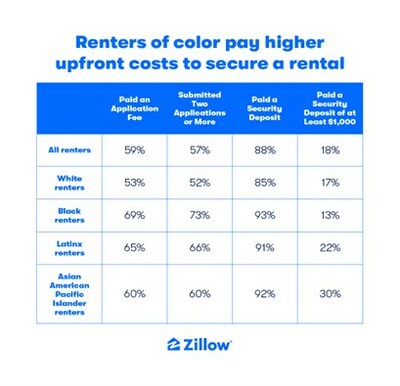
Renters of color pay higher upfront costs
PRNewswire
It’s more difficult than ever to afford a rental after prices skyrocketed during the pandemic. With affordability as tight as it is, the upfront costs for renting are a major burden that could put the cost of moving to a new rental out of reach. Renters of color are more likely to report paying these upfront costs, and oftentimes, the fees are higher.
According to Zillow’s Consumer Housing Trends Report1, the typical Black, Latinx and Asian American Pacific Islander (AAPI) renter all reported spending $50 per rental application while white renters reported paying $35. In addition to the higher amount spent, Black and Latinx renters were nearly twice as likely to report submitting five applications or more before securing a rental. (Thirty-eight percent of Black and Latinx renters report submitting five or more applications, compared to 21% of white renters.)
“Monthly rent prices are nearly the highest they’ve ever been, and unfortunately for so many people, finding a place to rent comes at an even higher cost,” said Manny Garcia, a population scientist at Zillow. “We so often hear about the benefits of renting and the flexibility it offers, but disparities persist, and many renters of color aren’t granted the same mobility as others because of higher upfront costs.”
Renters looking to lower the cost of application fees may have options. Zillow offers renters an online application process that provides renters with a single form they can use to apply to as many participating properties on Zillow as they’d like over a 30-day period for a flat fee.
Zillow data indicates that the average renter who used Zillow Applications in 2022 applied for at least three rentals. Considering the median application fee is $50 for renters who report paying one, Zillow’s application process could save the typical renter applying to three or more participating properties more than $100. Additionally, our universal application feature offers just a “soft” credit pull, protecting renters from having their own credit score impacted by applying for an apartment.
Application fees are not the only upfront costs to consider. Once a rental is secured, nearly all renters (85%) report putting down a security deposit. In 2022, the typical security deposit reported was between $500 and $999. This means that for renters who are already struggling financially, such as the 38% who said they couldn’t afford an unexpected expense of $1,000 in 2021, security deposits could be a significant obstacle to signing a new lease.
The burden is often greater for renters of color, who are more likely to report paying a more expensive security deposit: 39% of Latinx and 43% of AAPI renters paid at least $500 for their deposit, and 22% of Latinx and 30% of AAPI renters paid at least $1,000.
Given these affordability constraints, it’s especially important for renters to be aware of their rights in the communities where they are searching. Zillow rental listings display available local legal protections, including source of income and LGBTQ+ anti-discrimination laws. While source of income protections do not currently exist in all 50 states, Zillow believes families who depend on alternative sources of income, including housing choice vouchers, should be able to secure a comfortable home, free from discrimination. Zillow strongly supports efforts to expand these protections nationwide.



